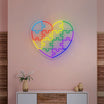Neon signs have evolved far beyond their traditional use in commercial signage and are now a vibrant element in contemporary art and home decor. Their versatility, boldness, and luminous appeal make them a favorite among modern artists, designers, and homeowners alike. Whether it’s a minimalistic living room or an edgy art installation, neon signs bring an electrifying energy that enhances the aesthetic value of any space.
What Makes Neon Signs a Popular Choice in Contemporary Art Decor?
1. Bold Aesthetic and Visual Impact:
Neon signs have an undeniable presence. The sharp, glowing lines and vibrant colors instantly capture attention, making them perfect for modern art decor. Whether used as standalone pieces or incorporated into a larger design scheme, neon signs create a focal point in any room. Their brightness and clean lines can transform even the simplest of spaces, lending a contemporary, high-energy feel. Artists like Tracey Emin and Bruce Nauman have integrated neon into their work, using it to communicate powerful messages in bold, electrifying visuals.
For instance, a modern art gallery might use neon to highlight an abstract art installation, with the bright colors drawing the viewer’s eye and adding dimension to the exhibit. Similarly, in a home environment, a neon sign featuring a phrase like "Live Bold" in a bright pink or blue can serve as a stylish centerpiece in a minimalistic living room.
2. Emphasis on Modernity and Innovation:
Neon signs represent a fusion of art and technology, which fits seamlessly into the ethos of contemporary design. With today’s emphasis on innovation and breaking traditional design rules, neon offers a refreshing departure from conventional decor elements. Its association with urban life, modernity, and even pop culture makes it a symbol of creativity and forward-thinking design.
Take, for example, an urban loft with exposed brick walls and concrete floors—an industrial aesthetic that’s popular in contemporary design. A neon sign featuring abstract lines or geometric shapes in neon blue or green would perfectly complement the room’s edgy, unfinished look while adding a futuristic touch.
3. Versatility Across Different Spaces and Themes:
Neon signs are incredibly versatile, making them suitable for a range of interior styles and themes. Whether you’re going for a retro vibe, a modern minimalist approach, or even a bohemian style, neon lighting can fit right in. This versatility also allows for artistic freedom, as neon can take virtually any shape, color, or form, giving designers and homeowners the ability to customize signs to match their vision.
For example, in a room dominated by natural wood tones and greenery, a neon sign in a soft, warm hue, such as amber or light yellow, can add a modern flair while keeping the overall ambiance calm and inviting.
How Can Neon Signs Complement Other Modern Design Elements?
1. Contrasting with Natural Textures:
One of the key aspects of contemporary design is the interplay between different materials and textures. Neon signs can be used to contrast with more natural, organic materials such as wood, stone, or plants. The cool, smooth glow of neon offers a sharp contrast to the warmth of wood or the roughness of exposed brick, creating a dynamic tension that enhances the room's overall aesthetic.
For example, imagine a living room with a modern farmhouse design: reclaimed wooden beams, neutral-colored furniture, and natural fiber rugs. Adding a neon sign that says "Gather" in soft white or green provides a modern twist to the rustic charm. The smooth, illuminated lines of the neon sign stand out beautifully against the raw, textured elements in the space.
2. Enhancing Minimalism with Bold Accents:
Minimalist interiors often rely on simplicity, clean lines, and a monochromatic color palette. While this approach exudes calm and order, it can sometimes feel a bit too understated. Neon artwork can serve as a striking accent in a minimalist room, breaking up the neutral tones without overwhelming the space. A neon sign’s sleek, glowing lines naturally complement the clean, pared-down aesthetic of minimalist design.
For instance, a minimalist bedroom with white walls, a gray bedspread, and light wood flooring can be instantly energized by a neon sign in a single, bold color—like electric blue—that reads "Dream On." This type of artistic lighting not only enhances the visual interest of the room but also reinforces the minimalist principle of “less is more.”
3. Playing with Light and Shadows:
Light plays a crucial role in modern design, and neon signs are a creative way to manipulate lighting in a room. The glow from a neon sign can cast interesting shadows and reflections, adding depth and dimension to an otherwise simple space. By placing neon signs near reflective surfaces like glass, mirrors, or even metallic accents, you can amplify the impact of the light, creating a visually dynamic and immersive environment.
Imagine a hallway with polished concrete floors and glass elements, illuminated by a neon sign featuring abstract shapes or patterns. As the light reflects off the surfaces, it creates a layered effect, transforming the hallway into a statement piece that feels both modern and artistic.
What Trends in Modern Art Can Be Translated Into Neon Sign Designs?
1. Abstract and Geometric Designs:
Abstract art has always been a hallmark of modernism, and its influence extends into neon sign designs as well. Geometric shapes, abstract lines, and minimalist forms are popular choices for contemporary neon art. These designs bring a sense of sophistication and modernity to any space, whether it’s a private residence or a gallery setting.
For example, an abstract neon sign featuring interconnected geometric shapes in varying neon colors can serve as a bold and eye-catching piece in a living room with modern furniture. These types of designs are versatile, complementing the sleek lines and open spaces typically found in contemporary homes.

2. Word Art and Inspirational Phrases:
Another trend in neon art is the use of word art or inspirational phrases. Neon signs that feature empowering words or quotes are a popular way to blend art with functionality, especially in home offices, kitchens, or even entryways. Modern typography and clean fonts make these neon signs feel trendy and contemporary.
For instance, a kitchen with a minimalist aesthetic could feature a neon sign above the dining table that says "Feast" in a stylish font. The sign not only serves as a decorative accent but also contributes to the room’s overall energy, making it feel more vibrant and welcoming.
3. Neon Art as Environmental or Nature-Inspired Designs:
With a growing focus on sustainability and eco-conscious living, nature-inspired designs are making their way into modern art trends, and neon signs are no exception. Designs that mimic natural forms like leaves, mountains, or oceans, but rendered in neon, are becoming increasingly popular. These signs can add a refreshing, nature-like element to an otherwise urban or modern space, blending the natural world with contemporary living.
For example, a neon sign shaped like a flowing river in cool blue or a series of glowing green leaves can introduce a sense of tranquility and nature into a sleek, modern interior.
How Can You Incorporate Neon Artwork Into a Trendy Living Space?

1. Feature Wall or Focal Point:
Neon artwork can be used to create a striking feature wall or focal point in any living space. Choose a large neon design—whether it’s an abstract pattern, a famous quote, or a unique symbol—and place it on a central wall. This becomes the visual anchor of the room, drawing attention and making a bold statement. To ensure the neon sign remains the focal point, keep the rest of the decor simple, with neutral colors and minimal patterns.
Example:
In a trendy, open-concept loft, a neon sign shaped like a stylized sun or moon can be placed on the main wall, standing out against exposed brick or concrete. This instantly becomes the centerpiece of the room, turning a plain wall into an artistic masterpiece.
2. Layered Lighting for Ambience:
Neon signs can be used to complement other forms of lighting, such as pendant lights, floor lamps, or sconces. By layering neon lighting with traditional light sources, you can create a cozy yet modern atmosphere in your living room. The key is to choose neon designs that don’t overpower the room but instead add to the ambient light.
Example:
A living room with soft, warm lighting can be further enhanced by a neon sign featuring a glowing outline of a palm tree or beach scene in soft pinks or greens. The neon glow complements the existing lights, adding a fun, contemporary vibe without being too harsh or overwhelming.
Conclusion
Neon signs have become a staple in modern art and contemporary home design, adding a unique blend of vibrancy, creativity, and style. Whether used as focal points, layered lighting elements, or subtle accents, neon signs complement a wide range of modern design elements, from minimalist decor to bold, industrial spaces. As trends in neon artwork continue to evolve, they offer limitless possibilities for incorporating light, art, and design into stylish home decor.





















